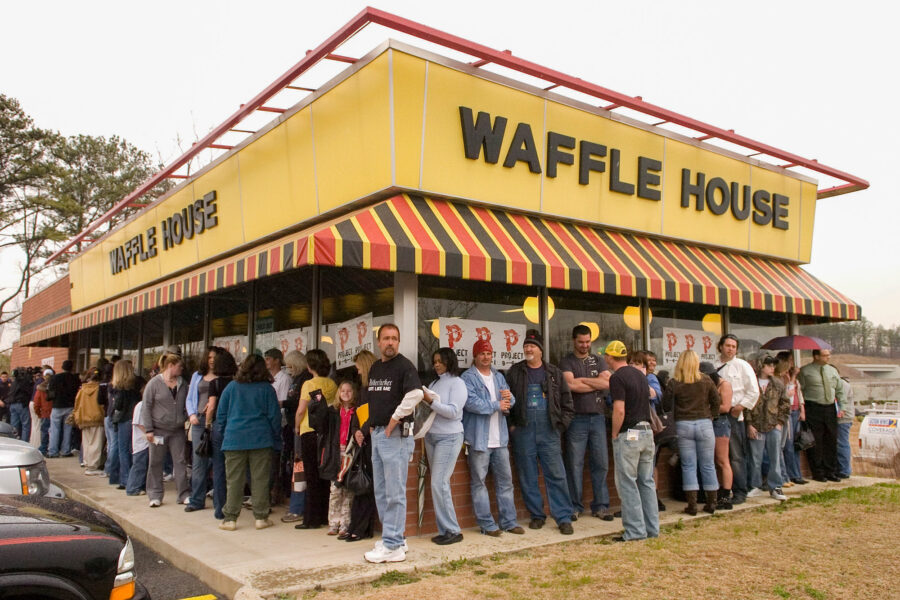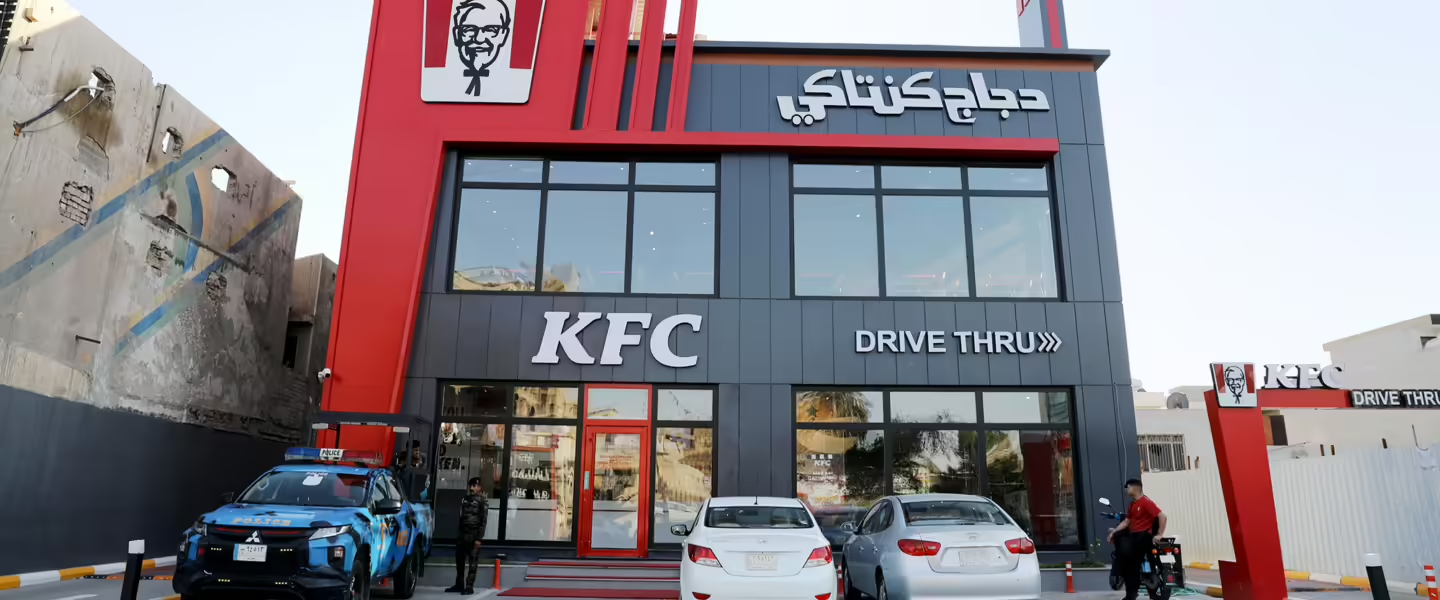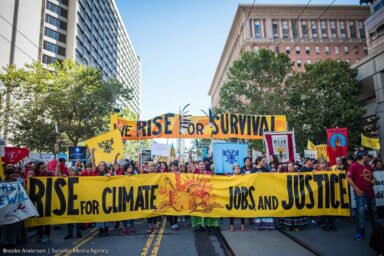Fast-food restaurants are the tip of the spear of empire, or the last outpost of civilization, depending.
|
Listen To This Story
|
The combo meal is the main course of empire, some say. Follow the light of the drive-thru to our salvation, say others.
We are watching a spiritual test of fast food right now. One that has nothing to do with the actual food. Two very different events — war and disaster — ask in two very different ways: What is fast food really saying as a symbol of deep-fried, Western-style civilization?
In late May, mobs attacked outposts of chicken franchises in Baghdad. The assaults went on for a week. In one case, men in SUVs pulled up to KFC restaurants, smashing windows and throwing chairs as patrons ran for cover. In another case, men on motorbikes threw grenades at a Lee’s Famous Recipe Chicken and a Chili House, which is Jordanian-owned but has made the understandable error of fashioning the restaurant as an American-style burger chain.
The attacks were prompted by Iranian militias. No civilians were hurt, but the message was clear.
“We are a group of people from this nation that protested against American interests,” an attacker told The Washington Post, which identified him as “a member of the Iranian-backed group Kataib Hezbollah” —
The militias, their statement said, “reject the use of Iraqi territory for investment projects” whose profits they claim are funneled to Israel and its armed forces. The United States is Israel’s closest ally and chief supplier of weapons and aid, but that assistance comes largely from the government.
KFC: secret conduit of funds to Israel, the Colonel remilitarized and with the blood of tens of thousands of Palestinians on his greasy hands. These are the days of chicken-fried geopolitics, in which one member of Iraq’s Counter-Terrorism Service, stationed out front of a KFC, said it best: “It feels weird to be deployed to protect a restaurant.”
Hearts and Stomachs
Fast food has long been a proxy, more than any other kind of franchise business, for the encroachment of American values. In the wake of the US invasion of Iraq in 2003, Hardee’s, Burger King, Papa John’s, and Church’s Chicken (called Texas Chicken there) followed. A Cold Stone Creamery opened there in 2022, attended by a US ambassador. As much as anything else, the militia was attacking a metaphor.
Anthony Pfaff, a senior fellow at the Atlantic Council’s Iraq Initiative, told Voice of America that “groups like [Kataib Hezbollah] are taking advantage of Iraqi popular sentiment that is against US support for Israel, and they are trying to make it appear as if these attacks on American restaurants are part of a popular uprising.” But, he says, most Iraqis aren’t interested in getting in the middle of a fight between the US and Iran. And since “a lot of the targeted locations are franchises often licensed to an Iraqi company,” it’s the locals who are “the first casualty of the assaults.”
While Iraqis may be against Israel’s attack on Gaza, they aren’t against the food. “When burger and fried chicken chains landed in Iraq, I never thought they could become the top categories [amid] local foods like shawarma, rice and stews and grilled meat,” said Yadgar Mirani, the co-founder of an Iraqi grocery delivery app.
The fight for hearts and minds doesn’t always reach the stomach. But, on a long enough timeline, the stomach wins out.
In June 1987, President Ronald Reagan gave his Berlin Wall Speech, famously demanding “Mr. Gorbachev, tear down this wall!” Eleven years later, the Cold War was over, and not only was there a Pizza Hut in Moscow’s Red Square, there was a Pizza Hut commercial in which Mikhail Gorbachev took a Russian child into the restaurant to introduce her to the deepest of deep-dish satire.
For many budding neoliberals, the former leader of the USSR gobbling the hot cheese of capitalism must’ve seemed like a confirmation of a theory, espoused two years earlier in 1996, by the economist Thomas Friedman. In his New York Times column, Friedman argued that international stability comes from being economically intertwined, or, as he put it, “No two countries that both have a McDonald’s have ever fought a war against each other.”
As a thinker, Friedman has many, shall we say, detractors, so his “Golden Arches Theory of Conflict Prevention” has been made quite a bit of sport of. In his defense, he gets out in front of criticism by declaring that the thought experiment is a “tongue-in-cheek,” though it’s clear he endorses its thesis, as he’s been nitpicking what is and is not a “war” for subsequent conflicts that do, in fact, have dueling McDonald’s.
Certain Iranian militias must be students of Friedman, though, because the attacks on Iraq’s chicken fortresses reflect something told to Friedman by the wonderfully named James Cantalupo, then-president of McDonald’s International (and so with something of a bias): “I feel these countries want McDonald’s as a symbol of something — an economic maturity and that they are open to foreign investments.”
So the KFC attacks capture a symbolic reality: a drive-thru insurgency against deep-fried imperialism. The sun never sets on the Big Mac.
But fast food isn’t just bad or good. If people like it, it sticks around, and soon it’s integrated into their society. In other words, if fast food is a symbol of Western-style civilization, at a deeper level, it can be a symbol — a useful one — for civilization itself.
Hash Browns at the End of the World
On July 8, Hurricane Beryl slammed into the Gulf Coast of Texas, knocking out power to millions in the Houston area. Citizens needed light, gas, and air conditioning, and the city’s energy provider offered, per a very good New York Times piece, “only basic information about outage numbers online, and no map showing where power has been restored.” People did what they had to do… what they’ve done since time immemorial: They turned to the website for Whataburger.
The burger chain is, for Texans, an unimpeachable cultural institution. In the wake of the hurricane, they looked on the site’s map of locations to see which lit up, and were therefore operating, and which were grayed out. Whataburger became a way to identify where the ragged edges of civilization began and ended. As a Texan, this makes me complexly proud: A beloved brand is more reliable than a utility. And at the edge of the wasteland, you can get a delicious Dr Pepper milkshake.

Using “fast food” as a proxy for “civilization” after a disaster is a well-established phenomenon. It’s called the Waffle House Index, a term coined by a FEMA administrator after the deadly Joplin tornado in 2011. Waffle House has locations all throughout the hurricane- and tornado-prone parts of the country, and has developed protocols: a robust supply line, warehouses for storing food temporarily, and “Waffle House jump teams” that can reopen restaurants quickly. The Index is a semi-official shorthand used by FEMA to establish how much an area has bounced back, and has three levels:
- GREEN: Serving a full menu and has power; the restaurant sustained little or no damage and has full power.
- YELLOW: Serving a limited menu, so maybe no electricity or running water, but there’s gas or a generator to make the basics: bacon, eggs, and coffee.
- RED: Closed; and since Waffle House has developed such robust response measures, they rarely close for long, so red indicates a truly apocalyptic scenario in which even fast food cannot survive.
Your fast-food franchise may be a secret hatch to the inner workings of empire, or just a place where the lights are reliably on. Their presence is always a brightly lit, though subtle, commentary on the forces that run our lives, natural and otherwise.
An Airbnb manager’s comment on the absurdity of the situation in Texas echoed that Iraqi Counter-Terrorism soldier forced to guard the KFC: “You shouldn’t have to resort to a fast-food restaurant app to get information about power.” She meant “electricity,” but it could just as easily be applied to many different flavors of power.




